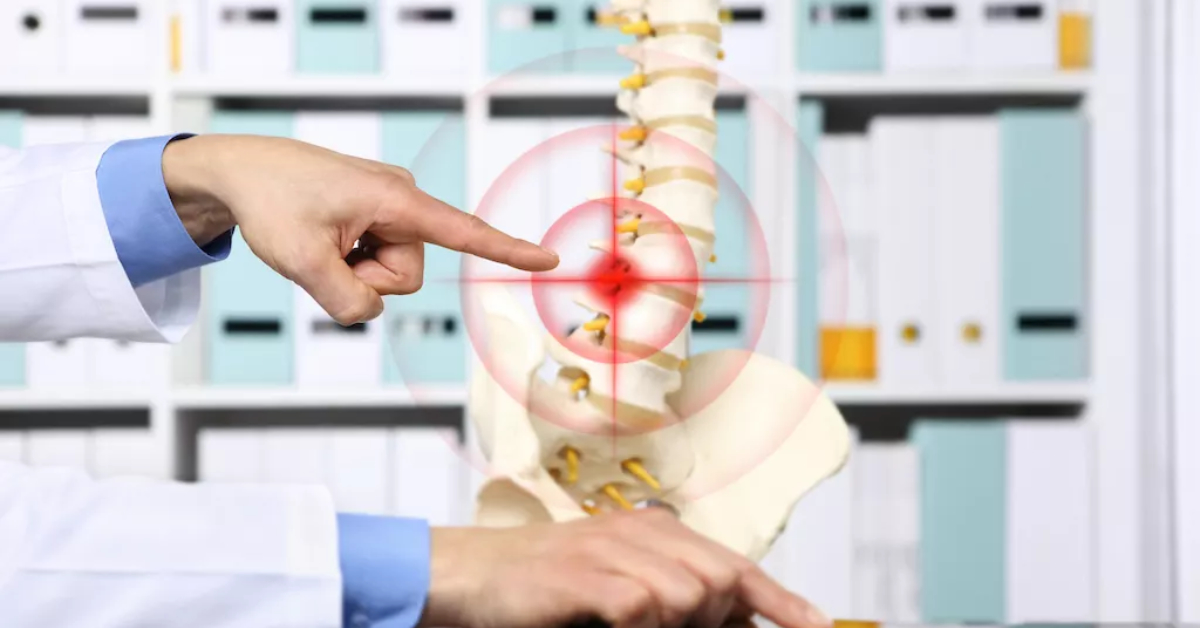
Do you suffer from lumbar spine pain? It may be radicular syndrome
Intense long-term pain in the lumbar spine which does not respond to treatment, and instead gets consistently worse. Pain radiating into the leg from below the knee to the foot, difficulty sitting or standing, inability to stand on tiptoes or heels or to lift the legs up stairs. Do you recognise your back pain symptoms? They may be caused by radicular syndrome, most often associated with intervertebral disc prolapse.
Why does disc prolapse occur?
Discs are cartilaginous plates (composed of an outer solid ring and an inner jelly-like core) inserted between the vertebrae. Their function is to cushion the impact between the vertebrae as “pads”. The spine, and therefore the discs, are affected by a number of risk factors, such as age-related degenerative changes, injuries, long-term excessive straining of the spine, especially when working for long periods standing or bending over, lifting heavy loads or sitting for extended periods of time, whether at a computer or in a car. Obesity, smoking and family history also play a role. Each of these factors can cause a breach in the outer ring of the disc, with the inner core mass pushing outward. The protruding disc mass can then put pressure on the adjacent spinal nerve root, which is perceived as pain.
What does “radicular syndrome” mean and who might be at risk?
A disc protrusion causes oppression, irritation or mechanical damage to the nerve root, which is why this type of pain is referred to as radicular syndrome. The lumbar region is the most commonly affected area (up to 90% of cases).
Back pain due to disc damage and degenerative changes in the spine is experienced by people aged 30-40 years and older, but even younger patients around 18 or 20 years old are no exception. If your pain has persisted for more than three months and you are experiencing any of the symptoms listed below, it is advisable to see a specialist as soon as possible and begin treatment. Firstly, to eliminate the problem in time, but also because of possible later recurrence, i.e., the return of difficulties that may developed into severe chronic pain.
Which typical symptoms indicate radicular syndrome?
Radicular syndrome is characterised by a series of symptoms referred to as radicular pain.
Patients most often experience:
- Stabbing, dull, burning or sharp throbbing unilateral pain spreading to the lower limb
- Loss of sensation or muscle strength in the limb, in the toes
- Inability to stand on tiptoe or the heels
- Tingling, prickling, burning, etc.
Another common cause of radicular syndrome is failed back surgery syndrome (FBSS), with up to 1/3 of patients developing epidural fibrosis (multiplied ligaments) in the epidural space after back surgery. This causes the pain to persist or new pain to arise even after back surgery.
Interventional pain treatment
Minimally invasive and endoscopic spinal procedures can provide effective relief of back pain and treatment of herniated discs. The foundation of treatment is a precise interventional diagnosis of back pain, and indeed the diagnostic procedures alone can relieve pain. During the endoscopic procedure, performed under the precise control of an X-ray machine with a mobile C-arm, the surgeon creates a single skin incision about 1 cm long, through which they introduce the instruments into the epidural space, as well as a special mini-camera that transmits the image to a monitor. This allows the precise and targeted removal of the prolapsed disc and, if necessary, further treatment of the epidural space.
Why choose minimally invasive and endoscopic back treatment?
Compared to conventional open surgery, these procedures have numerous benefits. A major advantage is the minimally invasive nature of the procedure, which is as gentle as possible for the patient. There is minimal risk of post-surgical complications, no damage to the muscles along the spine, which can be disrupted when using a conventional approach, and the risk of bleeding, infection or epidural fibrosis (ligamentous adhesions) is reduced. The procedures are performed under local or light anaesthesia (analgosedation), rarely under general anaesthesia, and without the need for hospitalisation. The patient returns home after the procedure and recommended rest period of about two hours. Another advantage is faster recovery and consequent quicker return to your daily activities, work and hobbies. Minimally invasive and endoscopic treatment is the ideal choice for any patient who does not want pain to continue hindering their life, work or leisure activities and seeks a quick, gentle and effective solution to their health problems. If you are interested in finding out whether treatment via minimally invasive and endoscopic methods may be a suitable solution for you, fill out the e-consultation and get the report!